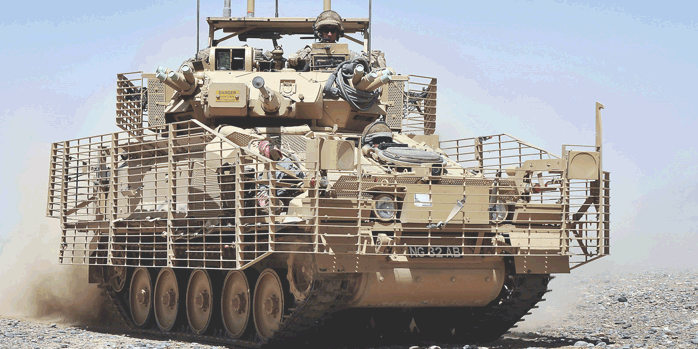Drive to survive: Motorsport’s role in strengthening the defence sector
Since World War One, the techniques used to develop racing cars have been crossed over to the military to build vehicles, tanks and aircraft. Yet it was during the early 2000s that this collaboration truly took off.
In 2006, the military needed to quickly upgrade the cooling systems of its CVR(T) (Combat Vehicle Reconnaissance Tracked) fleet for Iraq[1]. Lord Drayson, a racing enthusiast and Government spokesperson for Defence at the time, recommended the company NAR, who supplied the radiators for his Aston Martin GT racecar. Within a few months, the NAR upgrade doubled the cooling capacity and increased the efficiency of the charge air cooler by 75% [2]. Showcasing that the innovation and agility of the motorsport supply chain had the potential to transform the development of defence technology.
This was further demonstrated in 2010 when a consortium of motorsport specialists, including Ricardo, rallied together to answer the MOD’s call for an UOR’s (Urgent Operational Requirements) fleet of vehicles to replace the Snatch Land Rover. The result was the successful Foxhound LPPV (Light Protected Patrol Vehicle) which featured a V-shaped armoured hull for increased blast protection, independent axle suspension for manoeuvrability and interchangeable pods to suit different missions.
So, what makes motorsport relevant to the military and how else can it bring benefits to the battlefield?

Accelerated development
In racing, any issues with the car during Sunday’s race must be fixed in time for the next race the following weekend. This legacy has passed down through generations of motorsport, resulting in a supply chain that is responsive, flexible and fast. Defence on the other hand must navigate international politics, government bureaucracy and decisions made by committee, slowing development timelines to years instead of weeks.
‘Generally, the decision making and speed in defence is at huge contrast to motorsport,’ highlights Anthony Golland, Market Head of Defence at Ricardo. ‘For example, we developed processes to refurbish and replace all the final drive assemblies for the CVR(T) fleet from start to finish in two years, and in military terms that is considered rapid.
‘But all that changes during times of conflict, when things become more urgent,’ continues Golland. ‘For example, ifnce the MOD invokes asurge clause in a supplier’s contract, they could be required to ramp up their output, by three or four-fold in some cases. How well a supplier can flick that switch can win or lose defence contracts. So, it’s vital for defence companies to learn from the expedited nature of motorsport for both peacekeeping exercises and when in theatre.’
Learn more about how Ricardo supported the refurbishment of the CVR(T) final drive
Increase intel
One of the keys to enabling this rapid development is to streamline R&D through accurate data collection and analysis. Today’s Formula 1 cars are instrumented with around 300 sensors that capture over 250 million data points in real time[3]. Departments of engineers along with advanced AI tools decipher this information and extract the learnings which can then be used to enhance the next iteration of racecar.
‘One of the most transferable aspects of motorsport to defence is data collection,’ says Stuart Cooper, Market Head of Motorsport at Ricardo. ‘The more data you capture, the more potential you have to increase performance, and as teams visit the same tracks year on year, they build up comprehensive databases. This allows them to effectively set-up the car before they arrive at the circuit so they can focus on refining this set-up at the track.’
‘Armies work in very different environments, and it would take one cycle to collect all the necessary data,’ continues Cooper. ‘But as soon as that data is being recorded, the military will have a better understanding of the climates their vehicles operate in and how issues arise. This intel can then be used to accelerate the R&D phase, just like in racing, and overall reduce the time it takes to bring updates to the front line.’

Pioneering packaging
With military vehicles , it’s easy to think that space and weight are not a concern. However, the introduction of V-shaped hulls for increased blast protection from IEDs (Improvised Explosive Device) reduces available space, making packaging a priority.
‘During the Iraq and Afghanistan wars, the biggest threat to troops were IEDs and mines positioned in the ground,’ explains Golland. ‘A V-shaped hull helps protect the vehicle’s occupants from these devices because it pushes explosive forces out sideways, rather than hitting the flat underside of a horizontal chassis.’
‘So as V-shaped hulls have become a standard for safety, space claim is more difficult when upgrading existing vehicle platforms,’ adds Golland. ‘Packaging the engine, gearbox, power pack, drop box drive shafts along with all the other equipment and space for the troops in a much smaller volume has demanded more complex integration solutions.’
Motorsport pushes the boundaries of packaging, as demonstrated by the streamlined bodies of today’s Formula 1 cars that house over 13,000 components[5]. ‘Aerodynamics is king in racing, so teams are constantly trying to reduce the size of their racecars to minimise drag and maximise speed,’ says Cooper. ‘This has led to a creative approach to packaging which could be used to increase the capacity of defence vehicles to carry more equipment onboard.’
Lightweighting is another strategy tried and tested in racing that benefits defence. Although most championships have a minimum weight limit, to promote fair competition, teams make every effort to exploit exotic materials and the latest manufacturing methods to save grams. This not only helps them hit the minimum weight target but also have some control over the positioning of mass to improve car balance and handling.
‘Reducing the weight of a battle tank whilst maintaining the same level of occupant protection will increase its speed and manoeuvrability, which is crucial in combat,’ adds Cooper. ‘It also means more equipment can be carried for the same payload, so you don’t need additional power.’

The potential of hybrid and electric
Over the last decade, the pursuit for efficiency has led to electric and hybrid powertrains infiltrating almost every category of motorsport, which has caught the eye of aerospace, marine and defence. Maximum torque at zero revs, a reduced noise signature and less dependence on fuel are just some of the benefits of switching military vehicles to electric.
However, concerns over battery range, weight and degradation, along with the necessary charging infrastructure means that an all-electric vehicle fleet is unlikely until 2035. In the meantime, Defence sector’s future technology groups continue to focus on leveraging hybrid technology, with hybrid versions of several vehicle types most likely in development [6].
‘One of the advantages of hybrid and electric that is often overlooked is how this could potentially reduce the logistics burden,’ explains Golland. ‘It is often said that wars are not won on the battlefield but can be won through logistics.’
‘Challenges include the final mile delivery to the front line and also overall length of convoy supplying equipment stretching for several kilometres,’ continues Golland. ‘Using hybrid technology, such as regenerative braking, generates cheaper, more accessible onboard power which could shorten convey length and exposure to risk since less fuel and auxiliary generators may need to be towed.’‘
Another tactic would be to utilise autonomous vehicles to deliver supplies to the front line,’ adds Golland. ‘No crew means smaller vehicles, larger payloads and less risk, so this could also be where electric and hybrid drive systems add value.’
The trick to supplying Defence
The list of applicable technologies from racing to defence is endless, but regardless of the technology, each must go through the CADMID military equipment life cycle before deployment. Achieving this is one of the major hurdles for companies entering the military supply chain.
‘The CADMID cycle involves Concept, Assessment, Demonstration, Manufacture, In-service and Disposal phases,’ explains Golland. ‘It is extremely difficult to deliver this end-to-end development of a component or vehicle upgrade, but Ricardo has built up 110 years of experience in this field.’
‘Many consultancies focus on the concept and design phases of the development cycle, but our inhouse manufacturing capability and industrialisation expertise mean that we can also produce components and support production planning and supply chain activities,’ adds Cooper. ‘We are also involved in a variety of sectors including aerospace and in the case of motorsport can draw on the learnings from a variety of different championships, including Formula 1 and World Endurance Championship, to benefit our defence contracts.’
‘A positive military mindset is to look to the future to try and get ahead of the next technological trend,’ adds Golland. ‘There is a constant willingness to exploit innovation from different industries to solve problems. Importantly military end-users want pace and it wants innovation, which is unhindered by bureaucracy and inefficiency. But maybe motorsport is the key to unlocking that.’
References
[1] About NAR Group LTD [Online]. NAR Group Ltd.
[2] G.H., 2014. Technology Transfer [Online]. Defence Engineering.
[3] 2024. Beyond the flag: How The McLaren F1 Team races against the clock every week [Online]. Dropbox.
[4] 2024. Namer APC [Online]. Army recognition group.
[5] 2021. Explained | How to make an F1 car part [Online]. Aston Martin Aramco Formula One® Team
[6] J.L., 2023. JUST IN: All-Electric Army Vehicles Are Years away but Hybrids Are Rolling Out, Official Says [Online]. National Defense.
Subscribe or ask us a question
Subscribe for updates or get in touch with our experts about this article or about our motorsport services











